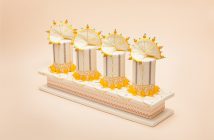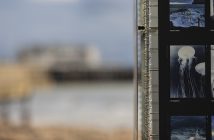I can’t say I’ve ever been much of a Pink Floyd fan. The songs I knew felt over-played, and others I’d heard seemed too abstract, too ethereal for my tastes. But by the time I walked out of the gift shop of Their Mortal Remains, the V&A’s exhibition about the band, I was clutching an abundance of LPs, a show catalogue, a T-shirt and as much memorabilia as I could weigh into a sizeable polythene bag.
I was a convert, completely in tune with their half-century influence on the music world, in awe of these titans’ game-changing concerts, privileged to have touched Gilmour’s guitar, remixed my own version of Money and had my photograph taken with the original 15-foot metal monoliths from the cover of The Division Bell.
As I write, I have cued up Meddle to reminisce on some of the best two hours of any exhibition I think I’ve ever experienced. And it is an experience. Less an exhibition, more an ‘audio-visual journey’, as the promotional literature puts it, ‘through their unique and extraordinary worlds’.

It begins with a long walk. It’s crowded, but ordered. As you enter, you’re given headphones which emit Echoes to take you into a scene-setting lobby of psychedelia before going Down the Rabbit Hole, the first of some dozen rooms that will walk you through their 52-year history. The headphones are the immersive part, fading as you approach certain video screens and exhibits to pick up the audio from the displays; with interviews, archive footage, insights and, of course, music.
Having set the scene, past a family tree of how the band was made up over the years, we learn the name derives from two blues musicians Syd Barrett had in his record collection, Pink Anderson and Floyd Council – thankfully they changed their name from The Tea Set in the ‘60s.
On the Highway introduces the band members. Packed with early memorabilia including Barrett’s letters, guitars, Nick Mason’s drumsticks, concert posters, ticket stubs, and some cracking insights – did you know they recorded their first album at Abbey Road while The Beatles worked next door on Sgt Pepper? – it provides the background to the band finding its feet and its form.

Where the exhibition becomes more of a show, distancing itself from other exhibitions before it, is in the room entitled Engineers of Experimentation, propelling you into the band’s distinct sound, sharing their first success, including a rich visual tribute to the 45-million-selling, 7000-copies-per-week, 17-years-on-the-billboard phenomenon that is The Dark Side of the Moon.
Once we’re up to speed, we get into the mindset of the band with Sonic Invention, featuring a panoply of musical instruments, mixing decks, amplifiers and keyboards, the audio now spilling out sound bites from the band about their method, clips of Gilmour demonstrating his technique and playing iconic riffs. It also features several synths and decks with which to experiment oneself, like a sort of Science Museum for grown-ups. It is, in three easy words, really really cool.
We reminisce a little more in Wish You Were Here, where notebooks pour with lyrics, and a plate of transparencies from the eponymous album cover (it’s the one with the businessman in flames) show the different takes it look to get that iconic image.
Just to add a counterbalance from all this bingeing, we get a room called Punk vs Pink, summarising the disparate musical sounds of the late 70s, as psychedelia came up against punk. And this being a Pink Floyd love-in, there’s a nice touch of an anecdote of John Lydon’s wherein his daubing ‘I Hate’ on a Floyd t-shirt eventually leads to his admission he secretly loved them.

It’s a short sting before the most ambitious room, The Architects of Rock. As well as Waters’ sketches and concept drawings of the sets for their shows such as The Animals and The Wall we’re met with replica models, Battersea power station and, of course, an inflatable pig; all attributable to Mason, Waters and Wright being architecture students together in London. It would stand to reason they would design the environments for their music as much as the music itself, bringing theatre to rock and roll, and establishing a new mould and scale for stadium rock.
Managing all this effort there is, naturally, a tribute to their crew in the room entitled It’s What We Do. Here, too, we have insights not just from the band but the designers, photographers, technicians. One such is Mark Brickman, their lighting artist, who gives a captivating interview on the design of their shows; and Storm Thorgerson discussing the Momentary Lapse of Reason album cover with its crazy shoot involving of hundreds of iron bedsteads.

Throughout, as well as coverage on the creation of each iconic album, the exhibition places the band and their work into a global, temporal perspective with telephone boxes that feature newspaper headlines of the time, putting context into the chronology. And the last is an empty phone box, as if to suggest there’s more to come.
By the end, as we enter the Performance Zone, a 360 video wall of the band’s videos and live performances, where one can sit, lie and lap up their music, I guarantee any viewer to not now be a fan.
You will end, as the show does, Comfortably Numb.
Pink Floyd: Their Mortal Remains has been extended due to phenomenal demand and now runs at the V&A until Sunday 15th October 2017. Tickets £20-£30. For more information, including some exhibitions highlights, special events, and to book, visit www.vam.ac.uk.




